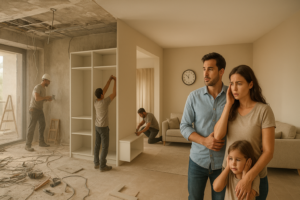When you purchase a new home or plan a major renovation, one of the most common questions people ask is: “Should I move in before interiors are done, or should I wait until everything is complete?”
At first glance, it may look like a simple decision. But in reality, this choice impacts your budget, lifestyle, safety, and even the overall quality of your interiors. In this blog, we will explore both sides of the question, giving you full clarity on when it makes sense to move in before interiors and when it is best to wait until the renovation is complete.
Understanding Interior Work Stages
Before answering whether you should move in before interiors or after, it’s important to understand the levels of work that typically happen in a home renovation:
- Civil works – breaking and rebuilding walls, flooring, bathroom renovation.
- MEP works – mechanical, electrical, and plumbing installations.
- Ceiling and gypsum works – false ceilings, ducting, AC setups.
- Lighting installation – electrical wiring, fixtures, concealed lights.
- Wall cladding and painting – decorative finishes, wallpapers, textures.
- Furniture and fit-out works – wardrobes, kitchen cabinets, modular setups, bespoke furniture.
These stages matter because some jobs generate dust, debris, and noise, while others are simple installation tasks. Moving in before interiors during the heavy construction phase can cause safety issues, delays, and extra costs.
Why You Should Not Move In Before Interiors
Let’s start with the most important advice: if possible, you should not move in before interiors are completed. Here’s why:
- Safety Hazards – During core renovation, there are usually 8–10 workers on site, using tools and machinery. If you move in before interiors are done, you expose yourself and your kids to risks from wires, tools, and dust.

- Dust and Debris – Civil works, plumbing, and wall treatments generate a large amount of dust, making the house unhygienic and uncomfortable to live in.
- Noise Pollution – Drilling, cutting, hammering, and grinding can make day-to-day living very difficult.

- Project Delays – Contractors work faster in an empty house. If you move in before interiors, workers must adjust around your schedule, slowing the project.
- Incomplete Experience – One of the biggest drawbacks of moving in before interiors is that you never get the “wow factor” of walking into a fully finished home. Instead, you deal with partial setups and constant adjustments.
In short, moving in before interiors are complete creates practical and emotional dissatisfaction.
When You May Have to Move In Before Interiors
Of course, sometimes you don’t have a choice. For example, your rental lease may be ending, or you may need to occupy the property quickly for personal reasons. In such cases, you can move in before interiors but with some conditions:
- Finish Core Works First – Ensure all major dusty and noisy jobs are completed. Civil, plumbing, bathroom, kitchen, and ceiling works must be done before you move in.
- Limit to Soft Installations – Move-in can be managed if only soft jobs like installing wardrobes, modular kitchens, or TV units are pending. These are prefabricated in factories and only require quick installation at home.
- Fix Working Hours – If you move in before interiors are finished, ensure workers operate only during fixed hours (like 8 hours a day) to minimize disturbance and safety risks.

While this option is not ideal, it is workable when circumstances demand it.
Planning Ahead Is the Best Strategy
The smartest way to avoid the dilemma of whether to move in before interiors or not is advance planning. Ideally, you should:
- Finalize your design concepts and layouts before signing the lease or moving in.
- Work with a reliable interior design company that can give you a clear timeline and Bill of Quantities (BOQ).
- Decide on materials, finishes, and aesthetics in advance so there are no last-minute delays.
- Allow at least 2–6 months for interiors depending on the size of your apartment, villa, or townhouse.
By planning ahead, you eliminate the need to move in before interiors are done and avoid stress.
The Emotional Aspect
Beyond safety and planning, there is also the emotional satisfaction factor. Moving into a home that is 100% ready gives you a sense of achievement and comfort. The joy of seeing your vision complete is far greater than living in a half-ready home where work continues around you.
When you move in before interiors are finished, you compromise on this feeling. Instead of excitement, you may feel restless, surrounded by dust, incomplete corners, and daily disruption.
Read more on Checklist: Things to Consider Before Starting Interiors in Your New Home
Conclusion
So, should you move in before interiors or wait until everything is completed?
The answer is simple: always try to complete your interiors first before moving in. This ensures safety, hygiene, faster project completion, and maximum satisfaction.
However, if you are forced to move in before interiors are complete due to external reasons, make sure all heavy and messy jobs are finished first, and only minor installations are pending.
At the end of the day, a home is a once-in-a-lifetime investment. Plan ahead, give your design team time to work, and move in only when your interiors are ready. This way, you get the full joy of stepping into a beautiful, complete, and safe home.